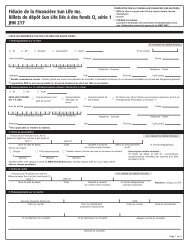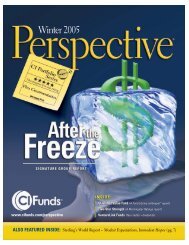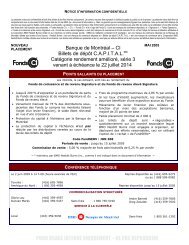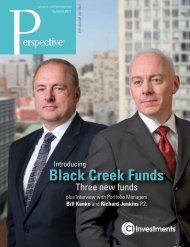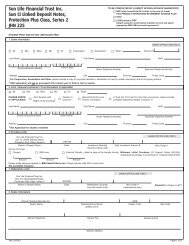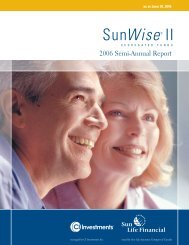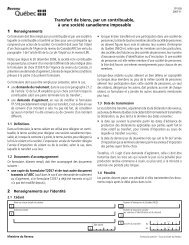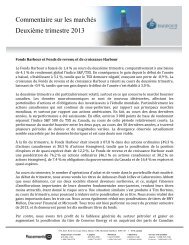COMMENTARYEpoch Investment Partners, Inc.Investment PartnersThe Power of Zero and the Dash for Trash in EquitiesIn the history of finance, interest rates have been the singlemost powerful driver of economic growth and decline. Andthe past several years have been no exception. Since thebeginning of the global financial crisis in the summer of2007, we have witnessed a collapse in equity prices and acontraction in real global GDP rivalled only by the GreatDepression. In response, governments and central bankstook action on several fronts. First, government stimulusplans were enacted that allowed for unprecedented levels ofliability guarantees and government spending. Second, andmost importantly, interest rates were slashed, dropping theshort end of the yield curve to just a hair’s breadth from zero.The impact of these astonishingly low interest rates is ourfocus here. Let’s start with Table 1, which shows whathappens to the value of a dollar when the discount ratechanges from a high number to a lower one. Should thediscount rate fall from 5% to 1%, for example, the presentvalue of a dollar due 20 years hence climbs from 38 cents to82 cents: an increase of 215%. The table demonstrates thatthe longer the duration of the asset in years, the greater theimpact of a given decline in the discount rate.Furthermore, compare the impact on the valuation of onedollar over five years with one due in 30 years. ContinuingPresent Value of a DollarPeriodsRates 1 5 10 20 306% 0.94 0.75 0.56 0.31 0.175% 0.95 0.78 0.61 0.38 0.234% 0.96 0.82 0.68 0.46 0.313% 0.97 0.86 0.74 0.55 0.412% 0.98 0.90 0.82 0.67 0.551% 0.99 0.95 0.90 0.82 0.74Source: Epoch, Investment PartnersTable 1: A decline in the discount rate will have its greatest impact onassets with longer durations.the example of a shift in the discount rate from 5% to 1%, anasset with a five-year duration rises 22% (.95/.78) whereas anasset with a 30-year duration gains more than 320% (.74/.23).In the case of a long duration asset containing option-likecharacteristics, its value explodes upward as rates approachzero. This is effectively what happened in the equity marketover the past 12 months.With the lessons of Table 1 in mind, let’s take a look ata real-life example. From the summer of 2007 throughtoday, Treasury Bill rates have fallen from 500 basis points to15 basis points, while 20-year rates declined modestly from5% to 4.5%. This downward shift in the yield curve haslowered the discount rate applied to all financial assets. Onecan debate whether it is the short-term or the long-term ratethat most affects equity valuations. Either way, it is clear thatsuch a shift has a powerful effect on valuation and favours theasset with the longest duration and highest risk. As previouslymentioned, the present value of equities possessing optionlikecharacteristics (funding problems, bankruptcy risk, orother forms of significant operational and financial leverage)will be affected more than the equities of companies withreal cash flows and solid balance sheets.Chart 1 offers yet another way to see the effects of themassive injection of liquidity by central banks and theaccompanying decline in interest rates. This chart of theBloomberg Financial Conditions Index shows that in thesummer of 2007, an event occurred that triggered a negativetwo standard deviation event. (The event was the inabilityof Paribas Bank to meet redemption requests on a fund itmanaged, which triggered a major liquidity injection intomoney markets first by the European Central Bank and thena day later by the U.S. Federal Reserve.) The index thenstaggered sideways for over a year until it finally collapsedwith the Lehman bankruptcy and the failure of AIG – anamazing 12 standard deviation event. The index reachedits nadir in October 2008 and look at what’s happenedsince. Today, the index scores a positive 0.5 or one-half ofone standard deviation better than its historical average.Indeed, the index is back to its level preceding the ParibasPAGE 42 • SPRING 2010 PERSPECTIVE AS AT MARCH 31, 2010
COMMENTARYincident. This index is the mirror image of the cost ofliquidity and reflects the power of zero when combinedwith liability guarantees on the valuation of financial assets.The power of zero also appears in the data presented inChart 2. Here we see the performance of the companies inthe S&P 500, with and without earnings. Stock prices of firmswithout earnings that were shaky financially and, in somecases, facing bankruptcy performed better than those withearnings. Hence, the more option-like the equity, the betterit performed over the past year as interest rates approachedzero and the cost of liquidity collapsed from the incredible12 standard deviation level shown in Chart 1. In Chart 2,we see how equity markets illustrated the lessons shown inTable 1. It literally was a dash for trash over the past year.While the power of zero has certainly had a dramatic impacton the recent history of the stock market, we believe it hasrun its course with respect to positive valuation influences.Future gains in the stock market will reflect the degreeof success of an economy transitioning from governmentstimulus and inventory building to one led by privatesector demand. Success will be determined by gains inemployment and rising personal income. Too little progressBloomberg Financial Conditions Index2.000.00-2.00-4.00-6.00-8.00-10.00-12.00Source: BloombergSMAVG Last Price (1)SMAVG Last Price (50)SMAVG Last Price (200)Jun Sep Dec Mar Jun Sep Dec Mar Jun Sep Dec Mar20072008 2009 2010Chart 1: The Bloomberg Financial Conditions Index combines yieldspreads and indexes from the money markets, equity markets, andbond markets into a normalized index. The values of this index arepresented as z-scores, which represent the number of standarddeviations from which current financial conditions surpass or lag theaverage of the 1992-June 2008 period. The chart shows that after amassive decline beginning in the summer of the 2007 and bottoming inOctober 2008, the index has rebounded to previous levels.2009 Quality Analysis: Earnings1601401201008060Jan Feb Mar Apr May Jun Jul Aug Sep Oct Nov DecDec. 31, 2008 = 100Source: Strategas ResearchS&P 500 Cos. WITHOUT Earnings: +69.7%S&P 500 Cos. WITH Earnings: +39.8%Chart 2: The chart shows that S&P 500 companies without earningssignificantly outperformed those with earnings in 2009, indicating thatthe lowest-quality companies benefited most from the sharp declinein interest rates.will trigger stagnation. Corporate earnings growth will bean important component, as will the effects of very strongcorporate balance sheets. External issues such as sovereigndebt concerns must be allayed and the balance sheets ofstate and local governments must improve. China needsto continue to grow and protectionism actions by ourCongress need to be held to a minimum. Put another way,the domination of the collapse of short-term interest rateson equity prices will now give way to other forces affectingequity prices.As investment managers, our task is to identify thosecompanies that will prosper over the long run and notbe swayed by the “power of zero” in the short run. Withinterest rates at present levels, that game has ended, butEpoch’s investment philosophy remains consistent. Firmsthat generate free cash flow and management teams thatdeploy this cash flow for shareholder value creation will win.These are the companies we seek to own in our portfolios.Managers: William Priest, David Pearl, Eric Sappenfield,Michael Welhoelter, Emily BakerAnalysts: Dina Dicenso, Kenneth Hightower, Thomas Hu,Janet Navon, John Reddan, David Siino, Richard Watt,Chris WoltersPAGE 43 • SPRING 2010 PERSPECTIVE AS AT MARCH 31, 2010
- Page 5: Signature Reportof the average bond
- Page 8 and 9: Signature ReportSignature Diversifi
- Page 10: Signature ReportMarket RoundupGloba
- Page 13 and 14: Signature ReportHealth careTechnolo
- Page 15 and 16: Signature ReportHigh-yield bondsGeo
- Page 17 and 18: Sterling’sWorld ReportIs Greece a
- Page 19 and 20: Sterling’sWorld Reportof only 3.7
- Page 22 and 23: Spotlight onStephen JenkinsGood man
- Page 24 and 25: Spotlight onStephen JenkinsHarbourF
- Page 26 and 27: Spotlight onStephen JenkinsAryzta A
- Page 28 and 29: Harbour Growth & Income FundHarbour
- Page 30 and 31: Balanced OpportunitiesFundHarbour G
- Page 32 and 33: CI IncomeOpportunities -Fund Highli
- Page 34 and 35: Reprinted with permission from The
- Page 36 and 37: COMMENTARYCambridge AdvisorsMost of
- Page 38 and 39: COMMENTARYFor the income portfolios
- Page 40 and 41: COMMENTARYquarters, the backdrop fo
- Page 42 and 43: COMMENTARYinventories throughout th
- Page 46 and 47: COMMENTARYTetrem Capital Management
- Page 48 and 49: COMMENTARYLegg Mason Capital Manage
- Page 50 and 51: COMMENTARYAltrinsic Global Advisors
- Page 52 and 53: pressure, investors will be searchi
- Page 54 and 55: Fund Factsas at March 31, 2010Fund
- Page 56 and 57: Fund Factsas at March 31, 2010Fund
- Page 58 and 59: Fund Factsas at March 31, 2010Fund
- Page 60 and 61: Fund Factsas at March 31, 2010Fund
- Page 62 and 63: Fund Factsas at March 31, 2010Fund
- Page 64 and 65: Fund Factsas at March 31, 2010Fund
- Page 66 and 67: Fund Factsas at March 31, 2010Fund
- Page 68 and 69: Fund Factsas at March 31, 2010Fund
- Page 70 and 71: Fund Factsas at March 31, 2010Fund
- Page 72 and 73: Fund Factsas at March 31, 2010Fund
- Page 74 and 75: Fund Factsas at March 31, 2010Fund
- Page 76 and 77: Fund Factsas at March 31, 2010Fund
- Page 78 and 79: Fund Factsas at March 31, 2010Fund
- Page 80 and 81: Fund Factsas at March 31, 2010Fund
- Page 82 and 83: Fund Factsas at March 31, 2010Fund
- Page 84 and 85: Fund Factsas at March 31, 2010Fund
- Page 86 and 87: CI Funds ® LEAD MANAGERCDN $FUND C
- Page 88 and 89: CI Corporate ClassLEAD MANAGERCDN $
- Page 90 and 91: Labour-sponsored FundsLEAD MANAGERC
- Page 92 and 93: CI Segregated FundsIssued by Unity
- Page 94 and 95:
Clarica PortfolioSegregated FundsIs
- Page 96 and 97:
SunWise ® I FundsBasic GuaranteeIs
- Page 98 and 99:
SunWise ® II FundsBasic Guarantee
- Page 100 and 101:
SunWise ® II FundsCombined Guarant
- Page 102 and 103:
SunWise ® II FundsCombined Guarant
- Page 104 and 105:
SunWise ® II FundsFull Guarantee c
- Page 106 and 107:
SunWise ® Elite FundsBasic Guarant
- Page 108 and 109:
SunWise ® Elite FundsCombined Guar
- Page 110 and 111:
CI Sales TeamNeal KerrSenior Vice-P
- Page 112:
2009Analysts’ ChoiceInvestment Fu





